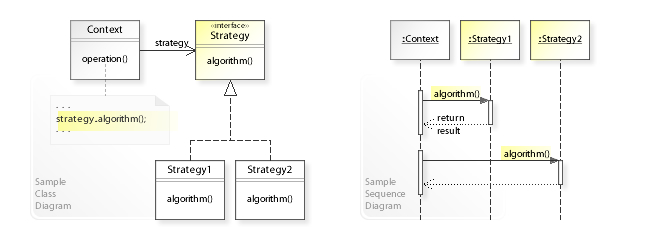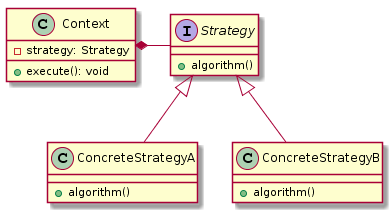策略器模式(Strategy Pattern)

定义: 策略模式的用意是针对一组算法,将每一个算法封装到具有共同接口的独立的类中,从而使得它们可以在运行时相互替换。
类型: 行为模式
UML
1
2
3
4
5
6
7
8
9
10
11
12
13
14
15
16
17
18
19
20
21
22
23
| @startuml
class Context{
- strategy: Strategy
+ execute(): void
}
interface Strategy{
+ algorithm()
}
class ConcreteStrategyA{
+ algorithm()
}
class ConcreteStrategyB{
+ algorithm()
}
Strategy <|-- ConcreteStrategyA
Strategy <|-- ConcreteStrategyB
Context *- Strategy
@enduml
|

角色说明
- 环境(Context): 持有一个策略的引用
- 抽象策略(Strategy/Policy): 抽象策略角色,通常为一个接口或者抽象类
- 具体策略(ConcreteStrategy): 封装了相关的算法或者行为
策略模式是对算法的包装,是把使用算法的责任和算法本身分割开,委派给不同的对象管理。
策略模式通常把一个系列的算法包装到一系列的策略类里面,作为一个抽象策略类的子类。
用一句话来说,就是:”准备一组算法,并将每一个算法封装起来,使得它们可以互换。
策略又称做政策(Policy)模式【GOF95】,如log4j2中的文件滚动就运用了该模式
策略模式实例
模拟商场平常时间的价格和打折时期的价格变化
打折策略 Strategy
1
2
3
4
5
6
7
8
9
10
11
12
13
14
15
16
17
18
19
20
21
22
23
24
25
26
| @FunctionalInterface
public interface Strategy {
int getPrice(int rawPrice);
static Strategy normalStrategy(){
return rawPrice -> rawPrice;
}
static Strategy discountStrategy(){
return rawPrice -> rawPrice / 2;
}
}
|
消费者 Context
1
2
3
4
5
6
7
8
9
10
11
12
13
14
15
16
17
18
19
20
21
22
23
24
25
26
27
28
29
30
31
32
33
34
35
36
37
38
39
40
41
| public class Context {
private final List<Integer> drinks = new ArrayList<>();
private Strategy strategy;
public Context(Strategy strategy) {
this.strategy = strategy;
}
public void add(int price, int quantity) {
this.drinks.add(this.strategy.getPrice(price * quantity));
}
public void print() {
int sum = this.drinks.stream().mapToInt((v) -> v).sum();
System.out.println("Total cost: " + sum);
this.drinks.clear();
}
public void setStrategy(Strategy strategy) {
this.strategy = strategy;
}
}
|
收银台 Client
1
2
3
4
5
6
7
8
9
10
11
12
13
14
15
16
17
18
19
20
21
22
23
24
25
26
27
28
29
30
31
32
33
34
| public class Client {
public static void main(String[] args) {
final Strategy normalStrategy = Strategy.normalStrategy();
final Strategy discountStrategy = Strategy.discountStrategy();
Context customer1 = new Context(normalStrategy);
customer1.add(100, 1);
customer1.setStrategy(discountStrategy);
customer1.add(100, 2);
customer1.print();
Context customer2 = new Context(discountStrategy);
customer2.add(100, 1);
customer2.add(100, 1);
customer2.setStrategy(normalStrategy);
customer2.add(100, 1);
customer2.print();
}
}
|
策略模式优缺点
策略模式主要是组织和调度这些算法(Strategy)
策略模式可以描述为: 策略算法是相同行为的不同实现
优点:
策略模式提供了管理相关的算法族的办法。策略类的等级结构定义了一个算法或行为族。恰当使用继承可以把公共的代码移到父类里面,从而避免重复的代码。
使用策略模式可以避免使用多重条件(if-else)语句
策略模式使用组合而不是继承。体现了Favor composite over inheritance的观点
缺点:
与桥接模式(Bridge)对比
Strategy模式注重于算法的封装,而Bridge模式注重于分离抽象和实现,为一个抽象体系提供不同的实现

